Micronutrients for Crop Production
Crop Insights by Steve Butzen, Agronomy Information Manager
- Summary
- Plant Requirements and Soil Availability
- Micronutrient Removal by Crops
|
- Detecting Micronutrient Deficiencies
- Managing Micronutrient Deficiencies
- References
|
Summary
- Due to higher yields, commodity prices and crop input costs, growers are reviewing all potential barriers to top grain production, including micronutrient deficiencies.
- In the major crops and production areas of North America, the micronutrients most often supplied by fertilization include zinc, manganese, boron and iron.
- Micronutrient deficiencies can be detected by visual symptoms on crops and by testing soils and plant tissues.
- The most reliable micronutrient soil tests are for zinc, boron, copper, and manganese. Though adequate, these tests are not as precise as those for soil pH, potassium and phosphorus.
- Plant tissue analysis is more reliable than soil testing for identifying many micronutrient problems, and can also supplement soil test information.
- Most often, micronutrients are soil-applied in a band at planting, or foliar-applied, as these methods allow lower use rates of sometimes expensive materials.
Micronutrients are essential elements that are used by plants in small quantities. For most micronutrients, crop uptake is less than one pound per acre. In spite of this low requirement, critical plant functions are limited if micronutrients are unavailable, resulting in plant abnormalities, reduced growth and lower yield. In such cases, expensive, high requirement crop inputs such as nitrogen and water may be wasted. Because of higher yields, higher commodity prices and higher costs of crop inputs, growers are reviewing all potential barriers to top grain production, including micronutrient deficiencies. This Crop Insights will discuss general micronutrient requirements, deficiency symptoms, soil and plant sampling, and fertilization practices. Future Crop Insights articles will discuss specific crops, their micronutrient or secondary nutrient requirements and management considerations.
Plant Requirements and Soil Availability
There are 16 elements essential to growth of crop plants:
Supplied by air and water: carbon, hydrogen, oxygen
Macronutrients: nitrogen, phosphorous, potassium
Secondary Nutrients: calcium, magnesium, sulfur
Micronutrients: boron (B), chlorine (Cl), copper (Cu), iron (Fe), manganese (Mn), molybdenum (Mo), and zinc (Zn).
Boron deficiency in alfalfa.
The 7 micronutrients are sufficient in most soils to meet crop needs. However, some sandy soils and other low-organic matter soils are naturally deficient in micronutrients, and high pH soils may make some micronutrients less available and therefore deficient. In the major crops and production areas of North America, the micronutrients most often supplied by fertilization include zinc, manganese, boron and iron. Basic chemical properties of micronutrients help determine their availability in soils (
Table 1).
Table 1. Chemical properties of micronutrients.
Because of complex chemical reactions within the soil, micronutrient availability is ultimately controlled by the equilibrium between the soil solution, soil organic matter, cation exchange sites, and insoluble compounds of micronutrients. Soil acidity or alkalinity has a large effect on the tie-up of micronutrients or their availability to plants. Micronutrients are most available in acid soils and often unavailable at high pH (
Figure 1).
Figure 1. Relative availability of micronutrients by soil pH¹.
Organic Matter
Organic matter is a reservoir for essential plant nutrients, continuously supplying these nutrients to the crop as it decomposes over time. This reservoir is especially important for anions such as boron, which do not bind to soil particles and are therefore subject to losses. Soils that receive regular additions of organic residues such as manures rarely show micronutrient deficiencies. An exception is deficiencies caused bynutrient imbalances, such as a deficiency of manganese caused by an excess of phosphorus in overly manured soils. Another exception is soils of extremely high organic matter such as muck or peat soils. In these soils, strong, natural chelation (the combination of a micronutrient with an organic molecule) can make some micronutrients unavailable, particularly copper, manganese and zinc.
Micronutrient Removal by Crops
Crop yields are continually increasing due to genetic improvements in stress tolerance and disease resistance, incorporation of insect resistance traits, and use of seed treatments and other crop protection products. This means that more micronutrients are removed from the soil by each harvest. An example of nutrient removal by two major crops is shown in
Table 2.
By comparison, corn and soybeans remove about 50 to 100 lbs/acre of P and K in the grain, so it is apparent that micronutrient needs are only about 0.1% to 1% of macronutrient needs (except for iron, which is higher.)
Table 2: Micronutrient uptake by corn and soybeans²
Detecting Micronutrient Deficiencies
Micronutrient deficiencies can be detected by visual symptoms on crops and by testing soils and plant tissues. To understand visual symptoms, it is useful to know the role each micronutrient plays in plant growth and development.
Functions of Micronutrients
Micronutrients differ in the form they are absorbed by the plant, their functions and mobility in the plant, and their characteristic deficiency or toxicity symptoms
(Table 3 and
Table 4).
Table 3. Functions of micronutrients in plants
3
Iron or zinc deficiency symptoms in corn. Soil and tissue testing can help determine which of these nutrients is deficient.
Micronutrient Deficiency Symptoms
Except for Mo, the micronutrients are considered weakly mobile or immobile in plants. This means that deficiency symptoms appear first or most severely on newest plant tissues (assumes plants started with some supply of the nutrient but ran out as plants developed.) For molybdenum, deficiency symptoms appear first on oldest plant tissues. Symptoms vary according to crop, but generalized symptoms are shown in
Table 4.
Table 4. General micronutrient deficiency symptoms
3
Micronutrient deficiencies usually have a patchy distribution in fields due to variation in soil properties that affect availability (e.g., pH, drainage, and salinity) and management history such as manure applications. Learning to identify deficiencies visually is important in recognizing problem areas and planning remediation for future crops. However, it is often too late for corrective action in the current crop by the time visual symptoms appear.
Common Micronutrient Deficiencies
The probability of a micronutrient deficiency is greatly increased on specific soils types and in certain crops (
Table 5).
Table 5. Soil conditions which may lead to micronutrient deficiencies for various crops.
4
Soil Tests to Detect Micronutrient Deficiencies
Many plant symptoms associated with micronutrient deficiencies, including stunting and chlorosis, may have a variety of causes, including disease, insect or herbicide damage, or environmental conditions. Soil and plant analysis are both useful in determining if the cause is truly nutritional. Though adequate for this purpose, micronutrient soil tests are not as precise as soil pH, phosphorus, and potassium tests.
The most reliable micronutrient soil tests are for zinc, boron, copper, and manganese. Because interpretations are soil specific, it is best to use locally calibrated recommendations. Soil tests for iron and molybdenum are considered to be of little value in predicting the supply of these nutrients in soils. When sampling for micronutrients, sample the root zone from 0 to 8 inches deep.
Plant Analysis to Detect Micronutrient Deficiencies
Plant tissue analysis is more reliable than soil testing for identifying many micronutrient problems, and can also supplement soil test information. Tissue testing is especially valuable in cases where reliable soil tests are unavailable. However, molybdenum and chlorine levels cannot be determined by this method.
Plant analysis can be used in two ways; one is to monitor the crop's micronutrient status, and the other is to diagnose a problem situation. By quantifying the nutrient content of tissues, plant analysis can point out an existing or potential problem before visual symptoms develop.
If in-season micronutrient deficiencies are suspected, plant samples should be taken as early as practical; treatments, when needed, should be made in a timely manner. Research has shown that once a micronutrient deficiency is detected, the plant has already suffered irreversible yield loss.
Because plant nutrient composition varies with the crop, age of the plant, part of the plant sampled and other factors, it is important to follow the standard sampling procedures provided by your plant diagnostic laboratory. In order to obtain a representative sample, take multiple plants from areas randomly distributed throughout the affected field area. Avoid border plants and those contaminated with dust, soil or foliar sprays. Taking samples of non-symptomatic plants to compare with apparent nutrient-deficient plants can increase the usefulness of plant analysis. Be aware that interpreting results is complex and may require expert advice.
References
1 Adapted from E. Truog. 1946. Soil reaction influence on availability of plant nutrients. Soil Science Society of America Proceedings 11, 305-308.
2 Adapted from D. Mengel, 1990. Role of micronutrients in efficient crop production. Purdue U. Extension pub AY-239.
3 Adapted from W.F. Bennett (editor), 1993. Nutrient deficiencies and toxicities in Crop Plants, APS Press, St. Paul, MN.
4 Adapted from Tri-State Fertilizer Recommendations for Corn, Soybeans, Wheat and Alfalfa, Ohio State University.
2002. G. Stevens, Motavalli, P., Scharf, P., Nathan, M., and Dunn, D. Crop nutrient deficiencies and toxicities. University of Missouri-Columbia Extension pub. IPM 1016.
2005. K. Kelling. Micronutrient management in the north-central US and Canada. University of Wisconsin, Madison. Presented at the llth Annual Southwest Agricultural Conference, Ridgetown, ONT.

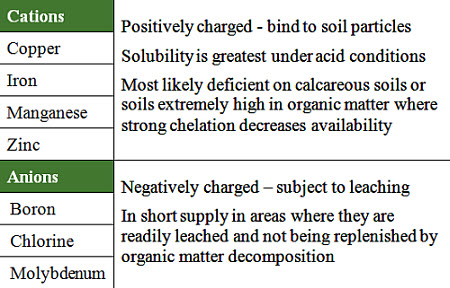
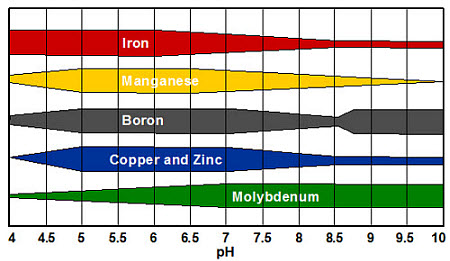
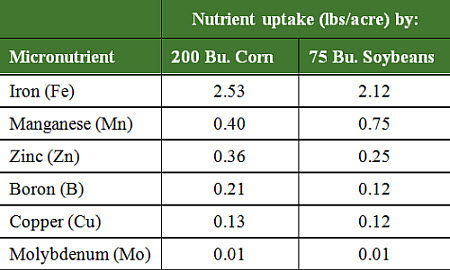
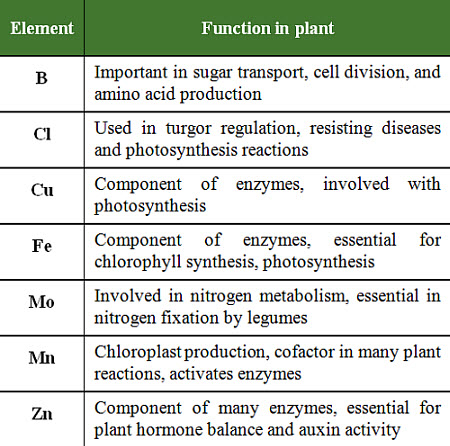
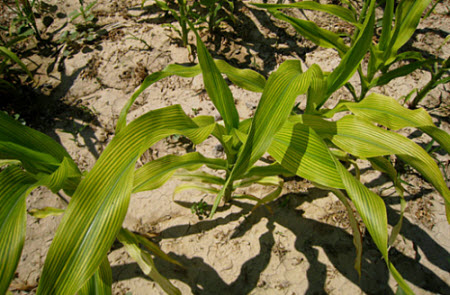
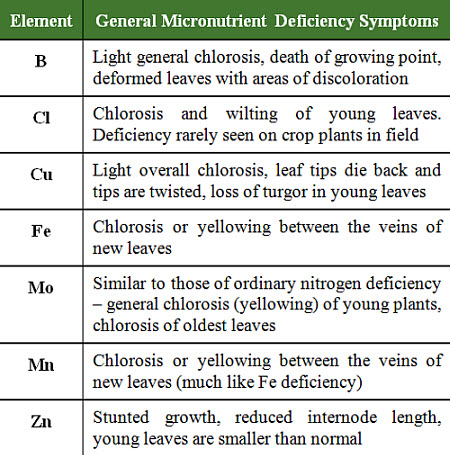
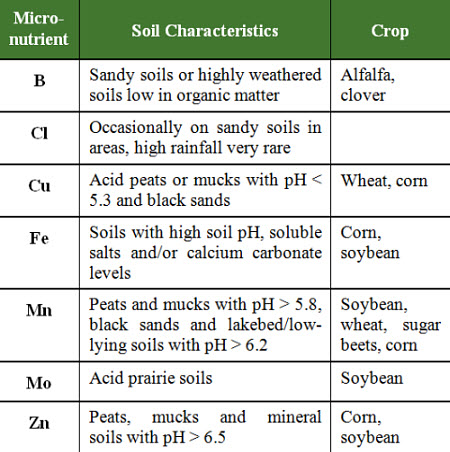
site promotion will always be a tedious job but you can outsource site promotion on some indian or pakistani guy- AMREP China
ReplyDelete